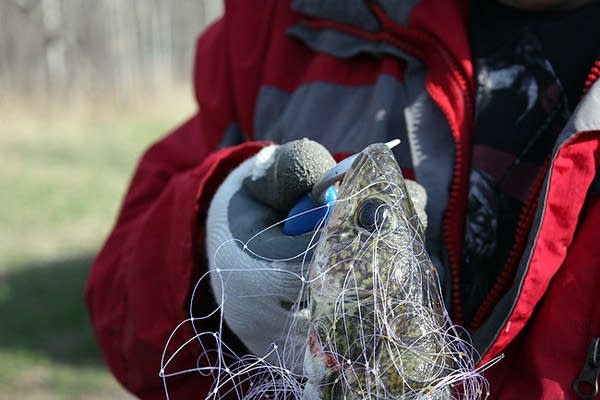Mille Lacs walleye rules meeting draws standing room only crowd

A town hall meeting Wednesday night on the north side of Lake Mille Lacs was packed, as Department of Natural Resources officials heard from area residents and business owners about how regulations on one of the state's most popular walleye lakes could impact the community.
The name of the game is going to be "small walleye friendly."
"Small walleye friendly just means setting regulations that don't target small walleye and setting other regulations for other species that might increase their survival," said Tom Jones, the DNR's treaties manager. "We want to put in a suite of regulations that will allow us to keep fishing."
Mille Lacs finds itself in a difficult situation. Tests last year prompted the agency and the tribes that also fish the lake to cut in half the total amount of walleye that can be harvested from the lake -- from 500,000 pounds last year to 250,000 pounds this year. Of that, sport anglers get roughly 180,000 pounds of walleye. And it's up to the DNR to make sure anglers stay within that limit. But that could be tricky this year. Last year sport anglers caught more than 300,000 pounds of walleye on Mille Lacs.
Create a More Connected Minnesota
MPR News is your trusted resource for the news you need. With your support, MPR News brings accessible, courageous journalism and authentic conversation to everyone - free of paywalls and barriers. Your gift makes a difference.
To stay within its limits, the DNR's Jones says this year, anglers will only be able to keep a narrow window in walleye they catch -- perhaps only one's between 18 and 20 inches long. Under current regulations, anglers must throw back walleye between 17 and 28 inches long.
Beyond what needs to be done this season, Jones said it's trying to let the lake's walleye population recover.
"The worst case we'd like to see would be to having to switch to catch and release," Jones said. "We'd rather not see that. But if we had to switch to something we'd rather switch to that than shut down the fishery."
Jones said the agency will probably liberalize regulations that promote the fishing of bass and pike that prey on young walleye.
Mille Lacs and fishing -- especially walleye fishing -- is a major economic driver for this part of central Minnesota.
At the meeting last night, resort owners, guides and other business owners around the lake expressed their concerns about this season's coming regulations.
Josh Bullivant, who works as a fishing guide at McQuoids Inn in Isle, said the region's economy this summer could take a hit.
"It's going to stink," Bullivant said. "It's going to hurt us. But we're still going to be able to catch fish. It looks like it's going to be still good fishing."
Things could get especially bad if anglers exceed their limit and the DNR has to implement catch and release.
"For some people the walleye's the fillet mignon," he said. "I mean that's our state fish. That's what everyone comes up here to catch is something to eat. I mean so yeah, some people may frown on catch and release."
At the same time, he says, there aren't a lot of place where you can go and catch so many fish -- even if you can't keep them all.
Suzy Fisher Anderson, owner of Fisher's Resort, was more direct about her thoughts on the upcoming walleye season.
"If the fish are biting in the beginning and they can still keep a couple I think we'll be OK. But if we go to catch and release it'll be devastating," she said.
But Fisher Anderson said if the DNR promotes catching other fish, like bass and pike, as the agency suggested Wednesday night, that could offset some of the business she's anticipating losing from walleye.
"If they're tired of walleye fishing, they're not keeping much, 'well let's go try and get some smallies. Not everyone around here eats smallies, but there are other people from other states that do eat smallies, so it might help with that," she said.
Whatever's decided, it's critical the DNR stay within its harvest level.
Don Pereira, a research biologist with the DNR, said if the state goes over the limit, not only would anglers be killing too many walleye, but they'd be exacerbating the population's decline.
Already, he says, next year there will be a decline.
"We don't have enough fish in those younger ages to replenish the fish that we're taking. We're still in a declining state," he said.
The DNR will announce walleye regulations on Mille Lacs before the season opener in May. Tribal and DNR biologists also plan to do a more detailed census study this spring.
